Create successful ePaper yourself
Turn your PDF publications into a flip-book with our unique Google optimized e-Paper software.
<strong>Better</strong> <strong>Queens</strong> <strong>by</strong> <strong>Jay</strong> <strong>Smith</strong><br />
of years ago a man came to see me who was conductor on a passenger train.<br />
He had held that position for 25 years and had laid up some money. He said,<br />
"I think I have served the people long enough as I have worked hard as<br />
conductor. I have about decided to buy a little farm and about 500 colonies<br />
of bees and just take life easy and let the bees work for me. What do you<br />
think of it?" I replied, "As conductor you just think you've been working.<br />
Now if you want to know what work really is you get 500 colonies, do all the<br />
work yourself, then you will realize that as conductor you just thought you were<br />
working." He insisted there could not be much work caring for bees. All there<br />
was to it, you just put on the supers and when filled take them off and people<br />
would come running for the honey. He may have been reading an<br />
advertisement of a supply manufacturer that ran something like this, "Costs<br />
little to start. Practically all profit. No experience needed. Very little work,"<br />
etc. What I am driving at is that most of us are like that conductor more or<br />
less and I hope less. That is the attitude many have in relation to mating<br />
hives. Many think that most any kind of box made of thin material will do.<br />
Nothing is farther from the truth, for the size and the way it is made is very<br />
important for best results. I have in the past, in an experimental way, made 16<br />
different styles of mating hives. I have made them in sizes as small as the on<br />
shown in the cut, which used a single individual comb honey section about<br />
one inch square, and from that up to a two-story jumbo hive. In Indiana we<br />
used a mating hive that held three four-<strong>by</strong>-five comb honey sections with a<br />
division board feeder at the back. It did very well in Indiana but was a<br />
complete flop here in Florida as I rather expected it would be. Here is the<br />
general rule: The smaller the mating hive, the less number of bees it requires<br />
and the less feed it takes to operate it. However it requires much more labor<br />
to operate it as constant care must be taken to see that it does not run short<br />
of stores and to see that it does not become too weak in bees or that it does<br />
not become too crowded with bees or stores, for if any of these conditions<br />
are present, the bees will abscond.<br />
http://www.bushfarms.com/beesbetterqueenswpics.htm (82 of 119)20-12-2006 21:42:55


